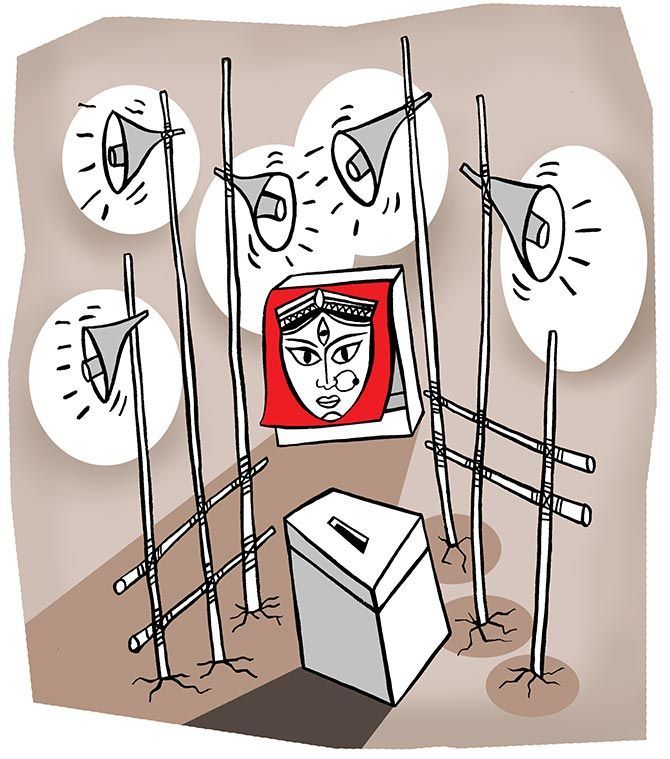 | « Back to article | Print this article |
'Perhaps the greatest curse that modern technology has inflicted on the people during the pujas is powerful public address systems that blare out songs which you have no option but to listen to,' says Subir Roy.
Illustration: Uttam Ghosh/Rediff.com

A cloud suddenly appeared over the Durga Puja in our neighbourhood which, said long-term locals, goes back at least 40 years. A group of young men sat around dejectedly outside the local club office in protest against the unthinkable development.
There would be no para puja this year. Lakhs of rupees are still owed by the puja committee to those who provided key services on credit last year -- from setting up the hugely elaborate pandal to supplying provisions for the community feasts.
It goes without saying that the office-bearers of puja committees are invariably politically powerful.
The roadside tea shop where I spend a bit of time every morning to keep my finger on the local pulse was agog with question and comment as to where the money went -- not just the subscriptions raised specifically for the pujas, but also the rent the club earns round the year from commercial tenants in the extended two-storied club building.
All acknowledged two realities: Politically powerful locals will run the community puja and they will spirit away a good bit of cash in the process.
What was considered unacceptable was the scale of cash disappearing last year.
The solution to the problem, which came in a couple of days, was also political. The local municipal corporation councillor, whose turf it was, stepped in to foot the bill for the current year.
He could hardly do otherwise as he would lose the support of the local boys if there was no puja and they missed out on the attendant fun.
Worship of goddess Durga was the core around which the institution of the barowari or community puja had been built. But in its totality it held up a great mirror to so many overriding realities in public life.
It is fascinating how large public pujas of Calcutta (as the British called the city then) have been the same in some critical ways since their inception over two centuries ago.
Ostentatious Durga Pujas became the autumnal hallmark of the city from the late 18th century when the new rich among the natives such as Munshis and Banias sought to use the festival as an occasion to entertain the sahibs.
Note that the pujas then reflected the political reality of the day. They were synonymous with wealth and elitism at a time when democracy was far away.
Today's pujas are much changed in many ways. They are no longer funded by individual rich patrons but are barowari pujas, where funding comes out of chanda (donations or contributions) from local businesses and residents.
Thus they are more democratic, but the reach of democracy is very limited. You cannot refuse to give a donation and the main beneficiaries, those who have most of the 'fun,' are the foot soldiers who occupy the bottom of the political pyramid of the day.
The pujas reflect popular culture and reality in other ways too.
There is an effervescence of popular art and creativity as there are innumerable pujas whose decorations, beginning from the pandal to what is inside, including the look and attire of the deities, are set to selected themes.
For example, there are bound to be many this year set to the theme of the Rio Olympics.
Just as the babus of old supported popular entertainment forms such as Tarja and Jatra, which had and still have a roaring puja season, in keeping with the times there are any number of local concerts in the evenings at puja pandals where the dominant act is singers prancing about the stage rendering popular Bollywood numbers.
In keeping with India's journey down the capitalist road, there are also any number of contests to judge the winners among the theme pujas sponsored by corporates.
While the theme decorations reflect tremendous innovative skills, some pernicious old practices remain.
The pandals, usually on roads, are anchored to the ground by digging numerous holes in them to house sturdy bamboos which hold up the edifices. These severely damage the road surfaces, as do the bamboo fencings along pavements to contain crowds, put up by digging holes along the sides of pavements which may have been recently tiled and resurfaced.
This is a regular yearly practice, but still there has been no attempt to think up an innovative solution for anchoring pandals and fences without damaging roads and pavements.
Perhaps the greatest curse that modern technology has inflicted on the people during the pujas is powerful public address systems that blare out songs which you have no option but to listen to.
One of the loudspeakers from our local puja is set up atop a tall tree that directly faces our apartment. By the end of the four puja days, our sense of hearing and peace of mind are largely gone.
Years ago, the courts ordered that all public address systems must be put off at 10 pm. But at our puja they have gone around it with great ingenuity. They have professionally created an announcement going into several minutes which begins with saying things like welcome to our pujas, then dished out homilies like mind your wallet and ends by wishing you the best, with snatches of music in between the announcements.
So they are not playing song and music, but making important announcements. This piece is played endlessly well after 10 pm. Why do it? For the local boys and their ilk, things don't feel festive unless there is a lot of noise.